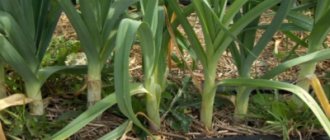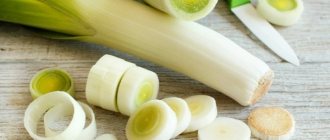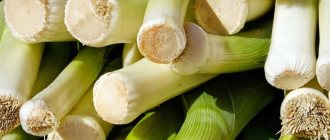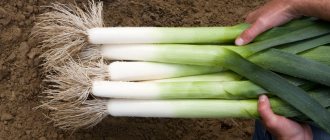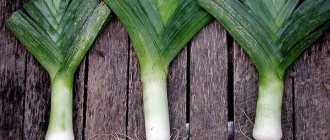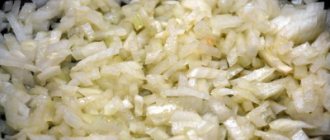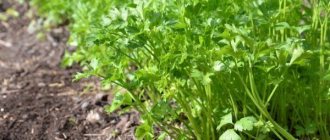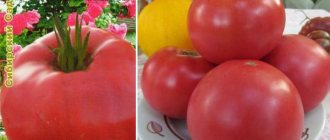Leek is a tasty and vitamin-rich biennial herb. It gained its popularity due to its taste and ease of care. The homeland of leeks is Asia and the Mediterranean, and the first people to cultivate this plant as an important vegetable crop were the Egyptians. Leeks are valued in Europe for their impressive amount of vitamins; they are added to seasoning mixtures, used in cooking as an addition to main dishes, and consumed fresh.
Is it possible to plant leeks before winter?
Leeks can be planted at several times. Most often they resort to spring planting. During this process, seeds are sown for seedlings in February, and the sprouts are moved to open beds in May. The harvest of such onions is harvested from August to October.
Summer planting is also possible. In this case, the plant produces a harvest for the next year. Gardeners often plant leeks before winter - in late autumn. Such plants sprout in the spring, and earlier than when planted through seedlings.
When to plant leeks depending on the region
In different areas of the country and the Near Abroad, the timing of planting leeks in the spring is not the same. Let's see when to plant leek seedlings in different regions.
| Region | Recommendations for planting leeks |
| Middle zone and Moscow region | The climate is quite mild. Spring warmth arrives in the third ten days of April, and in early May most vegetable crops are planted in the beds. The landing procedure begins at the following times:
Leek varieties are cold-resistant, but their seedlings are tender. Frosts can destroy them, so sowing in open ground is carried out after the beginning of May, when the threat of frost has disappeared. |
| Siberian region | This area has a harsh and changeable climate. Warm weather may set in in April, and then snow may fall again in May. Before planting tender leeks in open ground, you need to wait for stable heat. Leek varieties such as Vesta, Kilim or Goliath are sown as seedlings from the end of March. Late varieties Asgeos and Karantansky are usually sown before winter. |
| Ural region | In the Cis-Ural region the climate is wetter, milder and warmer. And in the Trans-Urals it is very similar to what is observed in Siberia. Leek planting in the Urals in the spring is scheduled for mid-May. Accordingly, seeds are sown for seedlings in mid-March. For the Trans-Urals, they adhere to the same sowing dates as in Siberia. The following varieties of leeks are grown in the Urals:
|
| South of Russia | Leeks are grown by sowing seeds in open ground. This procedure is performed in mid-April. If vegetable growers grow leeks through seedlings, then the seeds for seedlings are sown at the end of February, and the seedlings are also planted in mid-April. |
| Leningrad region | In this region and other nearby areas, seeds are sown for seedlings 10 days later than in the Moscow region. Seeds are placed in seedling boxes in the last ten days of March - the first ten days of April. Seedlings are ready for planting at the junction of May and June. |
| Ukraine | In the southern regions of the country, they adhere to the time limits for sowing seeds for seedlings that are intended for the South of Russia. And in the northern regions of Ukraine, seed sowing dates are adopted, which are followed in the Moscow region. |
| Belarus | This country is located slightly north of Ukraine, and therefore the timing of sowing leek seeds for seedlings is pushed back a week later than in the north of Ukraine. As usual, seeds are sown in seedling boxes at the junction of February and March. The seedlings are transferred to open ground in 60-80 days. |
Sowing leek seeds in open ground
Leek growing season
about 6-7 months, so seeds are sown in open ground to obtain salad greens at the end of July.
Sow seeds in the second half of April in shallow furrows, the distance between which is 20-25 cm, and between plants 15-25 cm, depending on the variety. The temperature should be 8-12 degrees at night and 20 degrees during the day.
Before sowing seeds, they must be treated (disinfected), especially for those collected in your own garden. First, place it in hot water (40-45 degrees) for several hours, then lower it into cold water.
To obtain quick germination, the seeds are still germinated. Moisten a cloth with water and place the seeds on top. Leave the seeds in a warm (20-25 degrees) place for 2-3 days.
Dry the hatched seeds for several hours so that they crumble and can be sown and sown in the ground.
If you use purchased seeds, there is no need to process them; sow them directly into the ground.
Video - Planting leeks in the ground
Types and varieties of leeks
According to the ripening period, leek varieties are divided into early, or summer, which are harvested in August or early September, mid-season, or autumn, ripening by October, and late, or winter.
The stems of early varieties of onions, which require from 130 to 150 days to ripen, weigh from 200 to 350 g and reach 3 cm in diameter. The leaves of early ripening varieties are narrow, green, sparsely and at an acute angle located on the false stem, and towards the end July they get rougher. The most popular early ripening varieties of leeks are:
- Columbus is one of the best early ripening varieties of Dutch selection with excellent taste. In adulthood, the plant reaches a height of only 70-80 cm, and forms a leg with a height of 20 cm, a diameter of 6 cm and a weight of 400 g. The advantage of the variety is that it does not need hilling to bleach the stem;
- Vesta is a productive variety, the plants of which reach a height of 150 cm, and the food stem, with constant hilling, can reach 30 cm in height and 350 g in weight. Vesta is distinguished by its wonderful sweetish taste;
- Elephant trunk - the leg of this variety is formed up to 30 cm high, but only as a result of repeated hilling. Elephant trunk is distinguished by its good sweetish taste and ability to be stored for a long time;
- Goliath is a plant with a bleached part up to 30 cm in height, up to 6 cm in diameter, weighing up to 200 g, with wide green or grayish-green leaves and a weak bulb;
- Kilima is a high-yielding mid-early variety, in which the bleached part reaches a height of 10 to 25 cm and 3-4 cm in diameter with a weight of about 150 g.
Mid-season leek varieties are not as productive as early ones, but they are superior in quality. These varieties require 150 to 180 days to ripen. Mid-season plants have blue-green leaves up to 7 cm wide and a stalk weighing up to 200 g and up to 25 cm high. The best varieties of leeks in this group:
- Jolant is a productive variety resistant to fungal diseases with a stem up to 35 cm high, a weakly expressed bulb and narrow, grooved, vertically arranged leaves of dark green color with an anthocyanin tint;
- Casimir is a tall and compact variety, characterized by productivity and resistance to fungi, with leaves extending from the stem almost vertically, a weak bulb and a bleached stem up to 25 cm high and up to 3.5 cm in diameter;
- Kamus is a medium-height variety resistant to fungal diseases with concave green leaves with a slight waxy coating, a weak bulb and a bleached stem up to 20 cm high and up to 2.5 cm in diameter;
- Tango is a highly productive frost-resistant variety with almost vertical leaves, a weak bulb, a stem up to 12 cm high, about 5 cm in diameter and weighing up to 250 g;
- Bastion is a spot-resistant, high-yielding variety with a stem up to 30 cm high and weighing up to 220 g.
Late varieties of leeks take a long time to ripen - more than 180 days. Their productivity is the same as that of mid-season varieties, but they are stored longer. The leaves of late onions are wide, blue-green in color, often with a waxy coating. They are located very tightly on the false stem and extend from it almost at a right angle, making the plants look squat. Their legs are dense, thick and short. Popular late varieties of leeks are:
- Karantansky - the height of the bleached stem of this variety reaches 25 cm, diameter - 4 cm with a weight of 200 grams or more. The leaves are wide, spreading, dark green with a strong waxy coating;
- Elephant is a frost-resistant and drought-resistant, spicy-tasting variety of Czech selection with a stem up to 25 cm long and weighing about 200 g, blue-green leaves with a strong waxy coating and a weak bulb;
- Bandit is a beautiful tall plant, bred by Dutch breeders, with a short, thick stem of excellent taste. The variety is cold-resistant;
- Autumn giant is another variety of Dutch selection, forming a large leg up to 40 cm high and up to 8 cm in diameter. The main advantage of the variety is its excellent keeping quality;
- Asgeos is a winter-hardy variety with wide dark bluish-green leaves, a mild bulb and a stalk of semi-sharp taste up to 20 cm high, but weighing up to 350 g;
- Mercury is a plant resistant to viral infections with dark green leaves, a stalk of semi-sharp taste up to 25 cm high and weighing up to 200 g.
Useful properties of the plant
Ancient Greek healers were the first to use pearl onions to treat many diseases. It was recommended for use by patients with gout and digestive disorders. Sailors consumed raw vegetables to prevent the most terrible disease - scurvy, which was caused by a deficiency of vitamins.
Modern gastroenterologists and nutritionists recommend eating this vegetable daily. Let's take a closer look at its beneficial properties and composition:
- Low calorie content (only 30 kcal per 100 grams), high dietary fiber content make this plant indispensable for dietary nutrition. There are many different diets based on this vegetable. It is used raw, dried or stewed.
- Due to the increased content of vitamin C and iron, the product is able to treat anemia. Iron helps increase hemoglobin, which saturates the cells of the whole body with oxygen. Vitamin C promotes its absorption, and also strengthens the immune system, the walls of blood vessels, and increases the viscosity of synovial fluid. The presence of vitamin C helps fight joint diseases.
- Cooks don't like leek leaves because of their rough texture. But in vain! They contain a large amount of dietary fiber that can increase the efficiency of the “lazy” intestines and remove waste and toxins from the body.
- The potassium content helps restore water-salt balance, has a beneficial effect on the cardiovascular system, and fights high blood pressure.
- Kaempferol and quercetin, which are part of the fruit, inhibit the development of cancer cells. Essential oils and flavonoids enhance immunity and have anti-inflammatory and diuretic effects. Their presence allows you to recover from cough, flu, gout, and urinary tract inflammation.
- The content of magnesium and phosphorus in this vegetable has a beneficial effect on the nervous system. These microelements increase attention, stimulate memory, and inhibit nervous excitement.
- The green part of the plant is rich in folic acid. It is very useful for pregnant women and prevents the development of neural tube abnormalities in the fetus.
- Eating leek lowers cholesterol levels and helps fight atherosclerosis. The presence of vitamin A and its provitamin β-carotene makes the crop beneficial for vision. The antioxidant properties of these substances are widely used in cosmetology to create anti-aging creams.
This is interesting! Many doctors note that leek is a powerful aphrodisiac. It is able to increase libido and has a beneficial effect on potency.
Daily consumption of this product, especially in winter, will help you compensate for the deficiency of important vitamins and improve your health.
Brief characteristics of the plant
Leek (Allium ampeloprasum) is a biennial plant belonging to the amaryllidaceae family. In the first year it forms a root system, a shortened stem and long leaves. In the next growing season, the plant produces flowers and seeds. In gardens, as a rule, it is grown as an annual. This bow came to Europe from Asia Minor in the Middle Ages. Leeks can be grown in all vegetable growing regions, in the Moscow region, Leningrad region, Siberia, and the Urals.
The plant is distinguished by a shortened stem and long green leaves. It is these two parts that are considered edible. The vegetable has a rather pungent, characteristic taste.
Beneficial features:
- has an antiseptic, that is, disinfectant and antibacterial effect;
- supports digestion;
- reduces blood sugar levels;
- due to easily digestible iron, it can be used in the treatment of anemia;
- affects the respiratory system, increases secretion (leek syrup);
- treats bad breath;
- Leek is considered an aphrodisiac and is beneficial for men.
Unfortunately, the vegetable can cause bloating; it is not recommended for people with peptic ulcers, stomach diseases, or pregnant women.
Leek has high nutritional value and contains:
- a lot of iron;
- folic acid;
- niacin;
- riboflavin;
- vitamins – B, A, C, E, K.
Leeks are fairly easy to grow. The growing season can last 70-170 days depending on the variety.
When to plant onions in the fall
The success of planting a vegetable plant depends on compliance with optimal timing and favorable weather conditions.
Calendar dates
Autumn planting should be done in November. In regions with warm climates, planting in December is possible. The timing will depend on weather conditions.
Weather
The air temperature at which it is worth placing seeds in the ground should not be lower than -1°C. It is important to wait for the right moment and cold temperatures so that the seeds cannot germinate before the onset of frost. Otherwise, the sprouts will not be able to withstand low temperatures and will die.
Did you know? On the walls of the Cheops pyramid there were inscriptions indicating the amount of onions and garlic that were allocated for the builders who erected it. These vegetables were introduced into the diet of workers to prevent epidemics.
Landing dates
As a rule, winter onions are planted in November. Specific dates are not tied to the calendar and depend on weather conditions , so before sowing they monitor the forecast.
Attention! In regions with warm climates, the crop is also planted in December.
Favorable days according to the lunar calendar for sowing leeks:
Suitable weather conditions
The air temperature should be within -1…+1°C . If it is warmer, the seeds will have time to germinate before frost sets in and the plants will die.
The culture loves humidity, so it is planted in cloudy weather .
How long does it take for leeks to sprout from seeds?
Leek seedlings
In principle, leek seeds germinate quite quickly. True, for this they need to create the right conditions. This means that they should have enough moisture in the soil, and the room temperature should not fall below +18. If all these rules are followed, the seeds will sprout within 5-7 days. If they germinate in not entirely correct conditions, then even 20 days may pass before the first shoots appear.
Harvest and storage
Leeks are removed gradually . Vegetables that are planned to be consumed immediately are dug up as they ripen. Harvesting onions for storage is extended until August.
Vegetables are carefully dug up with a pitchfork, being careful not to damage the roots . Leave them on the beds for about a day. Next, the roots are shortened by half, the leaves by ⅔.
Leeks are stored in the cellar for 6-7 months at a temperature of 0...+3°C, air humidity up to 85%. Vegetables are kept upright in wooden boxes with sand poured into the bottom.
Advice! In the freezer, leeks are stored 2 times longer.
Vegetables are kept on the balcony for 2-3 months if the temperature does not drop below -5°C.
Selecting a site for planting
To sow leeks, you should choose the optimal place, according to the preferences of the plant and the rules of crop rotation.
Placement of beds
Planting should be planned in an open area, well lit by sunlight and protected from winds from the north. Onions produce the best yields when grown on loose, fertile, loamy or sandy loam soil with a normal acidity level.
Crop rotation
In order to get high yields, prevent the development of diseases and attacks of harmful insects, when choosing a place, it is important to take into account what crops grew on it before. The best precursors for the described vegetable plant are different types of cabbage, potatoes, tomatoes, pumpkin, legumes, and greens.
It is worth refusing to plant onions in an area where carrots, corn, cucumbers, sunflowers, garlic, and various types of onions were previously cultivated. You can plant tomatoes, celery, and cabbage next to the leeks. Leeks can be grown in the same beds for no more than 2 years in a row. Subsequently, it is permissible to return the vegetable plant to the same place after 4–5 years.
Description of the variety
Leek is a biennial herbaceous crop, famous for its delicate taste and ease of cultivation. The vegetable adapts perfectly to different climatic conditions. The plant is quite powerful and tall. Its height can reach 80 cm. The leaves are long, flat, green with a bluish tint. Their arrangement is somewhat reminiscent of a fan. A special feature of the variety is the complete absence of a bulb. The white part of the plant and the base of long leaves are used for food. The upper part of the feather is unsuitable for food due to its rigidity and fibrous structure.
Its taste is somewhat similar to the taste of ordinary onions, but does not have its pungency and pungency due to the low content of essential oils in it. If you eat leek regularly, your metabolism will be restored, which is very important for those who want to lose excess weight. It is better to eat it in the form of salads, using it raw. During heat treatment, most of the beneficial substances contained in it are destroyed, especially when frying. Leeks are also often frozen for the winter. How you can freeze leeks so that all their beneficial properties are preserved is written in this article.
how to quickly lose extra 4-5 kg? To do this, you can arrange a cleansing diet for three days, which is based on soup made from one leek, two carrots, two tomatoes and a bunch of greens. Cook the food without salt for 20 minutes, and then leave for half an hour.
Preparation of planting material
Seeds must be prepared in a special way before planting:
- Calibrate: place them in a container with water, after 15–20 minutes remove those that float to the surface.
- Carry out disinfection: wrap in gauze and put in a solution of potassium permanganate for 15–20 minutes, and then put in a thermos with water heated to +45°C for several hours.
- Wash, dry and harden: place on the top shelf of the refrigerator for 12 hours.
If purchased seeds are used, you should pay attention to the packaging. If the seed does not require preplant preparation, the manufacturer will indicate this. It is not worth keeping the seeds in water to swell. When planting before winter, on the contrary, it is necessary to prevent the early emergence of seedlings, so dry seeds are placed in the soil.
Dates according to the lunar calendar 2022
Many gardeners are guided by the data of the lunar calendar (information is given according to the calendar from the magazine 1000 tips for a summer resident).
When to plant leeks for seedlings and in the ground in 2022:
- February: 6-8, 15-17, 23-25
- March: 8-12, 15-17, 27-29
- April: 6-13, 15-18, 24-26, 29, 30
For winter planting:
- November: 1-3, 6-8, 15-18, 24, 25
- December: 3-12, 13-15, 21-23
Unfavorable days for work:
- February: 4, 5, 19
- March: 6, 7, 21
- April: 5, 19
Open ground planting technology
The step-by-step sowing technology is as follows:
- Make grooves in the beds.
- Place the seeds in them, leaving gaps of 8–12 cm between them. The recommended row spacing is 20 cm.
- Sprinkle with a centimeter layer of peat.
- Water.
- Cover with film.
After the temperature drops below -1°C, it is necessary to equip the shelter with straw, dry leaves or snow. The insulation layer must be added periodically. The cover should be removed in the spring, when the frosts have passed. The film will need to be replaced with agrofibre - spunbond or lutrasil.
Planting seeds for seedlings
Landing dates
Sowing is best done in late February - early March
, at earlier dates, seedlings will require additional lighting.
Seed treatment, soil preparation and sowing
Before sowing, branded seeds are simply soaked for a day in water, changing it several times. Only seeds purchased at spontaneous markets or grown independently should be treated with disinfectants and growth-stimulating substances.
If you want to grow seedlings without transplanting, sow one seed at a time in cups 10-15 cm high or every 5 cm in seedling boxes of the same height so that the long roots of grown seedlings can fit there. From small dishes, sooner or later they will have to be planted, and picking, in principle, is not something obligatory for leeks.
Sow in a soil mixture of turf soil, humus and peat in equal quantities. Before sowing, it is moistened and compacted. In the box, the seeds are laid out in rows every 5 cm. Covered with the same soil mixture or sand with a layer of about 1 cm, lightly rolled. Cover the top with plastic wrap and place in a warm place.
Seedling care
Before sprouting, boxes or pots are watered moderately and be sure to ventilate frequently. As soon as the first shoots appear, the film is removed from them. Now, so that the seedlings do not stretch, they need to be provided with good lighting and coolness: 18-20 degrees during the day and 12-14 at night. Don’t worry if the seedlings do not develop as quickly as you would like - this is a feature of leeks; at first, its seedlings grow very slowly.
The crops are regularly watered and fed 1-2 times with a weak solution of mineral fertilizers, for example, azofoska (2-3 g/l of water). A week before transplanting to the garden bed, hardening begins, taking the seedlings out into the open air.
Errors during cultivation
If you do not follow the rules of cultivation and care, then leeks can be affected by various diseases or pests. First of all, pay attention to the following nuances of care.
- Plantings use only healthy and strong planting material. Before planting, seeds are treated with potassium permanganate or any other fungicide.
- When planting, take into account the rules of crop rotation.
- To prevent diseases, if necessary, lime the soil.
- Fertilizers are applied systematically and regularly. They strengthen the immunity of plants, which makes them invulnerable to diseases.
- All residues and weeds are destroyed in a timely manner.
If you follow simple rules, then leeks will give a good and healthy harvest at the right time.
Anyone can grow leeks in their own garden bed. To avoid failure, initially choose the variety and sowing date wisely. If you plant leeks for seedlings in 2022 according to the lunar calendar, the result will be strong and viable seedlings. When planting, the climate is taken into account and favorable conditions are provided for the crop.
Save and share:
Useful articles for gardeners:
Recommendations for choosing a planting date. Which variety to choose
The homeland of leeks is Western Asia. This is a biennial, cold-resistant and moisture-loving plant from the Onion family, reaching a meter in height.
Description of culture
In 1 year of life, the plant grows roots with a false white bulb. The diameter of this bulb reaches 8 cm, and its length is no more than 12 cm. The false bulb is used as food.
In the 2nd year, a peduncle grows, reaching a length of up to 2 meters with flowers of pink or white color. The seeds reach ripeness in the first week of September and remain viable for 2 years.
Attention! If there are errors in caring for the crop, a flower shoot may form in 1 year of life and then the leek will become unsuitable for consumption.
The plant has green leaves of a pinnate type, similar to a lancet. They grow 60 cm long on the stem. You can also eat them in early spring.
Photo by Chris Penny
Types and varieties of leeks
The whole variety of varieties of pearl onions is divided into 3 varieties:
- early;
- mid-season;
- late.
When choosing the time to plant leeks for seedlings, it is important to take into account the characteristics of these varieties:
| Early ripening varieties | Mid-season varieties | Late ripening varieties |
| An edible “leg” is formed within 100-140 days of the growing season. Its greens are low-fiber, tender, and readily eaten. It doesn't matter how the harvest is stored. | It will take from 140 to 160 days for a mid-season leek to ripen. Compared to earlier varieties, it forms shorter and thicker “legs”. This harvest can be stored for 70 days. | Late-ripening varietal varieties of pearl onions ripen in 180-200 days. They can be grown as seedlings or grown in heated greenhouses. By the end of winter, a good harvest of leeks is harvested. These varieties have a more powerful “leg”, reaching a diameter of up to 7 cm, but its length is no more than 20 cm. |
The most popular of the early varieties are the following:
| Among the mid-season varieties, the most widespread are:
| Of the late varieties, the most commonly grown are:
|
Important! Late varieties during storage increase the content of vitamin C by 3 times. They can be stored for several months.
Leeks can be grown from seeds as well as through seedlings. In the southern regions, it is grown by sowing seeds in garden beds. In other areas it is grown through seedlings.
When choosing a variety, the region where the crop is cultivated and the personal preferences of the gardener are taken into account. If leeks are grown for fresh consumption, then an early variety should be grown. If the goal is to preserve the harvest during the winter, you need to cultivate a late-ripening variety.
Landing dates
In practice, there are 3 methods of growing leeks from seeds:
- seedling;
- sowing seeds in the ground in spring;
- winter planting of onions.
For each area, certain varieties of pearl onions and methods of growing them are recommended. The seedling method is often used.
When choosing a method of cultivation through seedlings, gardeners should know that the age of the planted seedlings should be equal to half the growing season of a particular variety. Early leek seedlings enter open ground at the age of 60 days, mid-season leeks - 75 days, and late ones, respectively, 90-100 days.
Photo by funcrush28
Are leeks afraid of spring frosts?
Frosts slow down the development of leeks.
In some sources you can find information that leeks tolerate light frosts quite calmly. This is why some novice gardeners make the mistake of planting seedlings in open ground without waiting for positive temperatures at night.
Thus, they make a big mistake since this information concerns exclusively adult and mature plants. If you plant leek seedlings in the soil during frosts, they will inevitably begin to hurt. Yes, it is likely that it will not die, but it will begin to grow and develop intensively only after the temperature ceases to drop below +12 degrees.
Cleaning
Leek harvesting must be completed before the first frost arrives, since this cold-resistant plant can withstand frost only down to -7 degrees. As a rule, leek harvesting begins after the air temperature drops to -3 degrees.
Armed with a shovel or pitchfork (the latter option, which prevents damage to the bulbs, is preferable), the plants are carefully dug up and laid out for a short time on the edge of the furrow, allowing them to dry out a little. After this, having cleared the soil and shortened the roots to one centimeter, the leek is transported to the storage location.
In order to prevent rapid withering of leeks, which is fraught with the loss of their unsurpassed taste, you can trim the leaves by only one third. It is also unacceptable to completely cut off the roots, without which the leek will begin to rot.
Plant care
Caring for a vegetable plant that is planted before winter does not differ from that carried out during normal planting. It consists of regular watering, fertilizing, loosening, mulching, weeding, hilling, preventive measures against diseases and harmful insects.
Important! Fertilizers should be applied only to well-moistened soil. Fertilizing carried out in dry soil leads to burns of the root system.
Top dressing
In order for the plant to grow strong, have good immunity and bear fruit well, it should be fed 4 times a season. When drawing up a feeding schedule, you can use the recommendations given in the table:
| Application period | Fertilizer |
| 20 days after emergence | Urea (20 g) + potassium monophosphate (sulfate) (10 g) + water (10 l). Working fluid consumption: 1 l/1 m² |
| Subsequently, 3–4 weeks after the next feeding | An aqueous solution of mullein (1:10) or an aqueous solution of bird droppings (1:10) + wood ash |
Watering
Leeks love moisture, so watering must be mandatory and regular. Interruptions in moisture and drying out of the soil should not be allowed. The recommended watering regime is 1–2 times a week. The amount of moisture must be adjusted according to weather conditions - increase if there is a dry season, and decrease during the rainy season.
To retain the required amount of moisture when the plant has already formed a strong stem, the beds should be mulched. Straw, peat, humus, and hay are used as mulch. The next day after watering, you need to loosen the soil to avoid the appearance of a dense crust on the surface and improve the passage of moisture and oxygen to the roots.
Disease Control
Leeks, as a rule, are characterized by strong immunity and good resistance to diseases and pests. However, if mistakes are made during planting and care, it can be affected by pathogens of peronospora and rust. To prevent these diseases, treatments with Fitosporin are used, which are carried out 2-3 times every 2-3 weeks. The most dangerous pest for onions is the onion fly. For the purpose of prevention, it is necessary to cover the beds in April-May (during the insect’s flight) with agrofibre and spray with Iskra and Fitoverm.
Important! In order for the onion leg to grow well, as well as for the purpose of bleaching it, 2-3 hillings should be done per season.
Pests and diseases of leeks
The most dangerous disease for leeks is mosaic - a viral disease carried by aphids. You can identify the mosaic by the longitudinal yellow spots on the leaves of the onion. Affected plants are stunted in growth.
Leeks also suffer from fungal diseases: downy mildew and rust. Downy mildew, or downy mildew, manifests itself as rapidly growing oval spots on onion leaves. Affected plants become inedible.
Rust is also a fungal disease. It can be recognized by the bright yellow pads of fungal spores that appear on onion leaves. As they mature, the pads darken, then turn black, and the affected leaves dry out.
The main pest of leeks is the onion fly, which can cause irreparable damage to the crop. The onion fly can be seen already in mid-May - at this time it lays eggs in the soil and on the leaves, and after a couple of days larvae will appear, feeding on the central part of the onion, causing it to rot and wither.
Leek processing
To protect the crop from onion flies, pollinate the area with wood ash at the rate of one glass of ash per m² of bed. Instead of ash, you can use tobacco dust or a mixture of tobacco dust and ash. Treating the soil and plants with ground pepper repels flies (one teaspoon of pepper per m² of land). Whatever you use to pollinate the leeks, after processing, be sure to loosen the soil to a depth of 2-3 cm.
A remedy such as tobacco infusion has proven itself well in the fight against pests. It is prepared like this: add a tablespoon of liquid soap and 200 g of tobacco to 10 liters of hot water, leave for several hours, then filter the infusion and spray it on the plants.
In order to reliably scare away the onion fly from the leek, you can plant celery between its rows.
How to deal with leek diseases? The causative agents of fungal diseases are destroyed by treating the plants and soil on the site with a solution of Fitosporin or copper oxychloride. Unfortunately, viral diseases, like a mosaic, are incurable, so the fight against them is carried out only by agrotechnical methods:
- compliance with crop rotation;
- combating weeds and harmful insects;
- using disinfected seeds for sowing;
- immediate removal of affected plants from the garden bed;
- growing resistant varieties of leeks.


